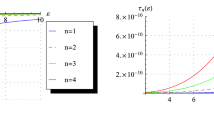Abstract
The influence of a magnetic field on the Rashba spin–orbit interaction in an anisotropic quantum dot is theoretically studied, and the expression of the ground state energy of a magnetopolaron is obtained with the Pekar variational method. The ground state energy of the magnetopolaron splits into two branches due to the Rashba effect, and the splitting appears saturated phenomenon with increasing the transverse and longitudinal effective confinement lengths. Because the contribution of the magnetic field cyclotron resonance frequency to the Rashba spin–orbit splitting is a positive value, the energy spacing becomes larger as the magnetic field cyclotron resonance frequency increases. Due to the spin–orbit coupling interaction, the energy splits at zero magnetic field. The total energy is reduced due to the presence of phonons. Therefore, the polaron state is more stable than the bare electron state, and the polaron energy splitting is more stable.



Similar content being viewed by others
References
E I Rashba and AI L Efros Phys Rev Lett. 91 126405 (2003)
S A Wolf, D D Awschalom, R A Buhrman, J M Daughton, S von Molnar, M L Roukes, A Y Chtchelkanova and D M Treger Science. 294 1488 (2001)
F Chi, L Liu, and L Sun Chin Phys B. 26 037304 (2017)
F Chi and L -M Liu Int J Theor Phys. 57 562 (2018)
F Chi and L –L Sun Chin Phys Lett. 33 117201 (2016)
Y J Chen, H T Song and J L Xiao Indian J Phys. 92 587 (2018)
Y J Chen, H T Song and J L Xiao Superlattices Microstruct. 118 92 (2018)
Y J Chen and X Wang Int J Theor Phys. 57 3540 (2018)
Y J Chen and P Y Zhang J Low Temp Phys. 194 262 (2019)
S Datta and B Das Appl Phys Lett. 56 665 (1990)
Y J Chen, W F Liu and F L Shao Physica E. 110 15 (2019)
Y J Chen, C F Cui and H T Song Physica E. 111 130 (2019)
J Lee, H N Specror J Appl Phys. 99 113708 (2006)
A M Babayev, S Cakmaktepe and D T Altug J Opto Biom. 1 137 (2009)
S S Li and J B Xia Nano Res Lett. 4 178 (2009)
J P Stanley, N Pattinson, C J Lambert and J H Jefferson Physica E. 20 433 (2004)
P Mokhtari, G Rezaeiand and A Z Amani Superlattices Microstruct. 106 1 (2017)
F M Peeters, X G Wu, J T Devreese Phys Rev B 33 3926 (1986)
S P Shan, S H Chen and J L Xiao J Low Temp Phys, 176 93 (2014)
Acknowledgements
This work was supported by Natural Science Foundation of Fuian Province (Grant No. 2019J01797).
Author information
Authors and Affiliations
Corresponding author
Additional information
Publisher's Note
Springer Nature remains neutral with regard to jurisdictional claims in published maps and institutional affiliations.
Rights and permissions
About this article
Cite this article
Shan, SP., Chen, SH., Zhuang, RZ. et al. Influence of a magnetic field on Rashba spin–orbit interaction in an anisotropic quantum dot. Indian J Phys 95, 1085–1089 (2021). https://doi.org/10.1007/s12648-020-01774-8
Received:
Accepted:
Published:
Issue Date:
DOI: https://doi.org/10.1007/s12648-020-01774-8




